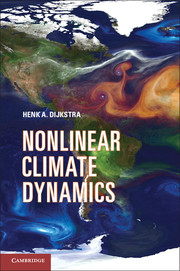Book contents
- Frontmatter
- Contents
- Preface
- Acknowledgements
- 1 Climate Variability
- 2 Deterministic Dynamical Systems
- 3 Introduction to Stochastic Calculus
- 4 Stochastic Dynamical Systems
- 5 Analysing Data from Stochastic Dynamical Systems
- 6 The Climate Modelling Hierarchy
- 7 The North Atlantic Oscillation
- 8 El Niño Variability
- 9 Multidecadal Variability
- 10 Dansgaard-Oeschger Events
- 11 The Pleistocene Ice Ages
- 12 Predictability
- References
- Copyright Acknowledgements
- Index
8 - El Niño Variability
Published online by Cambridge University Press: 05 June 2013
- Frontmatter
- Contents
- Preface
- Acknowledgements
- 1 Climate Variability
- 2 Deterministic Dynamical Systems
- 3 Introduction to Stochastic Calculus
- 4 Stochastic Dynamical Systems
- 5 Analysing Data from Stochastic Dynamical Systems
- 6 The Climate Modelling Hierarchy
- 7 The North Atlantic Oscillation
- 8 El Niño Variability
- 9 Multidecadal Variability
- 10 Dansgaard-Oeschger Events
- 11 The Pleistocene Ice Ages
- 12 Predictability
- References
- Copyright Acknowledgements
- Index
Summary
A swinging theory
DGDGA∧D, California Dreamin', Chris Proctor
About once every four years, the sea-surface temperature in the Eastern Equatorial Pacific is a few degrees higher than normal (Philander, 1990). Near the South American coast, this warming of the ocean water is usually at its maximum around Christmas. Long ago, Peruvian fishermen called it El Niño, the Spanish phrase for the Christ Child.
Phenomena
During the past several decades, El Niño has been observed in unprecedented detail thanks to the implementation of the TAO/TRITON array and the launch of satellite-borne instruments (McPhaden et al., 1998). The relevant quantities to characterise the state in the equatorial ocean and atmosphere are sea level pressure, sea-surface temperature (SST), sea level height, surface wind and ocean subsurface temperature.
The annual mean state of the equatorial Pacific sea-surface temperature is characterised by the zonal contrast between the western Pacific “warm pool” and the “cold tongue” in the eastern Pacific. The mean temperature in the eastern Pacific is approximately 23°C, with seasonal excursions of about 3°C. What makes El Niño unique among other interesting phenomena of natural climate variability is that it has both a well-defined spatial pattern and a relatively well-defined time scale. The pattern of the sea-surface temperature anomaly for December 1997 is plotted in Fig. 8.1 and shows a large area where the SST is larger than average.
- Type
- Chapter
- Information
- Nonlinear Climate Dynamics , pp. 167 - 201Publisher: Cambridge University PressPrint publication year: 2013



